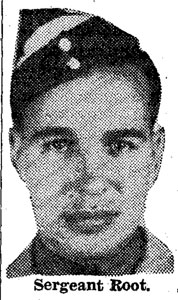Spitfire R7265 near Barnard Castle.
On 24th September 1942 the pilot of this 403 Squadron Spitfire took off from Catterick with at least one other aircraft to undertake a combined formation flying and cine gun flying exercise. During the exercise the pilot of this aircraft appears to have lost control while flying in cloud at 5,000 feet and the aircraft went into a dive from which the pilot was unable to recover from and it dived into the ground at 11.15hrs. Sadly he was killed instantly and the aircraft was destroyed. The location of the crash is widely referred to as being near the village of Whorlton, around three miles east of Barnard Castle. Whorlton is in Durham not Yorkshire. In trying to locate whether his death occurred inside Yorkshire one route I use is to check the deaths index and in this case that states that his death was registered in Durham. Normally this would mean that the death occurred in Durham but a farm at the other side of the River Tees is quoted in the accident records. The other side of the River Tees is Yorkshire. I therefore have created a webpage for this incident.
Spitfire R7265 was built to contract 19713/39 by Vickers Armstrong's (Supermarine) Ltd at Eastleigh and was first test flown on 25th March 1941. Four days later it was flown to 6 MU at Brize Norton. It was taken on charge by 91 Squadron at Hawkinge on 2nd May 1941 but on 13th June 1941 it returned to Hawkinge with battle damage and was assessed as having sustained Cat.W/FB damage. This damage was deemed severe but on 17th June 1941 it was transported by road to AST Ltd. at Hamble for further assessment. They then re-assessed it as being repairable so repaired it. On completion of repair it was flown directly to 72 Squadron at Biggin Hill on 30th September 1941 who then moved to Gravesend on 20th October 1941. On 5th December 1941 crashed on take off from Gravesend when the engine failed. Repairable Cat.R/FA damage was the assessment and it was transported by road to Westland Aircraft Ltd. at Yeovil for repair. On 25th July 1942 it was taken on charge by 313 Squadron at Churchstanton. On 23rd August 1942 it was transferred to 403 Squadron at Catterick. As a result of the crash on 24th September 1942 Cat.E2/FA damage was the recorded assessment and it was struck off charge the same day. It had flown a total of 179 hours. The aircraft was a presentation aircraft, subscribed for by the people of Grimsby and it carried the name "Grimsby I".
Pilot - F/Sgt Kenneth Ellwood Root RCAF (R/90493) aged 24, of West Lorne, Ontario, Canada. Buried Catterick Cemetery, Yorkshire (O.O./6).
Kenneth Root was born on 15th July 1918 at Eden Mills, Ontario, Canada and was the son of Robert Henry and Clara (nee Entwhistle) Root. As a young man he worked in his father's general store and while studying at high school and also after leaving high school. He enlisted for RCAF service on 3rd April 1941 for aircrew service and after pilot training was awarded his pilots' wings on 16th January 1942. With his training in Canada complete he was posted to the UK soon after and trained at 5 (P)AFU and 61 OTU before posting to 403 Squadron on 25th August 1942.
His older brother Clayton Edward Root RCAF (R/261128) was sadly killed on RCAF service on 22nd March 1945 while flying with 431 Squadron. He was on bard Lancaster KB808 that crashed in Germany with the loss of the whole crew. His body is now buried in Hanover War Cemetery having been initially buried near the crash site. I would suggest that he must surely have visited his brother's grave while stationed at Croft with 431 Squadron.

